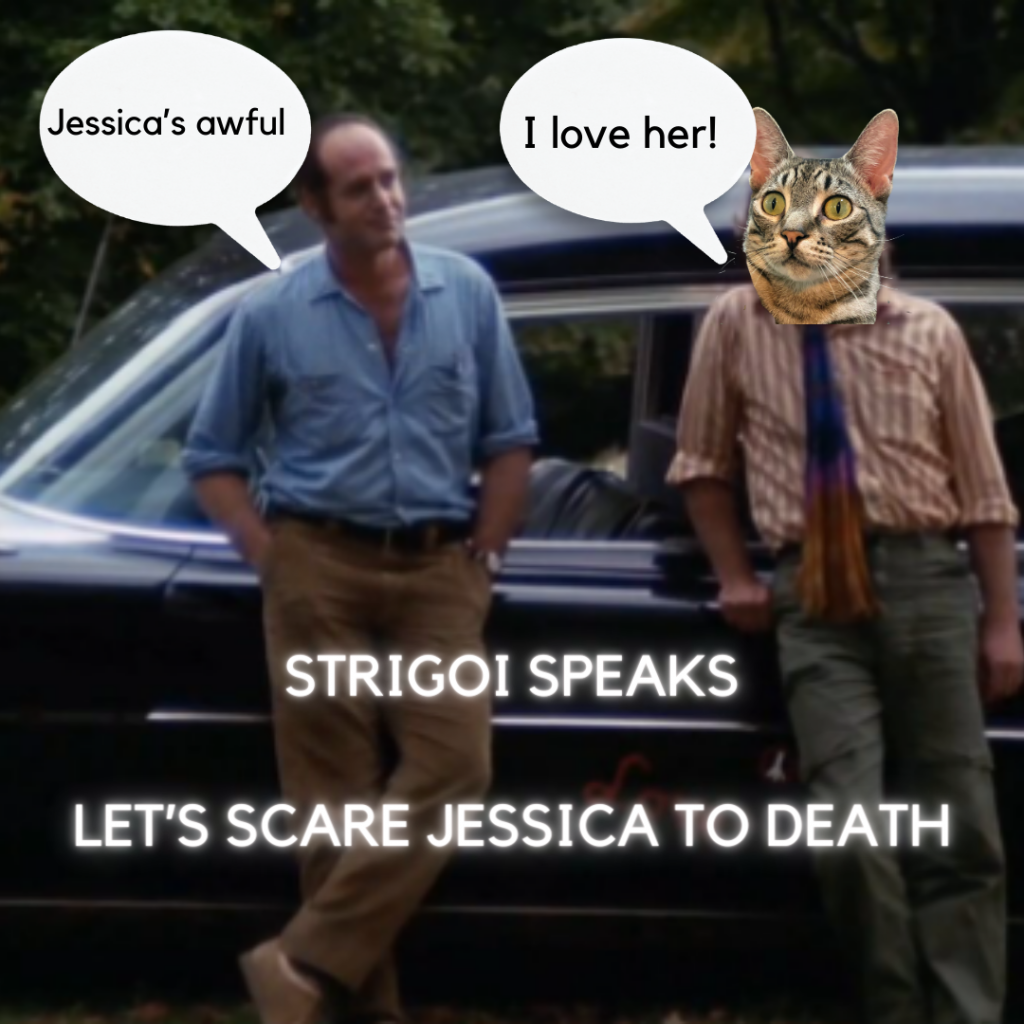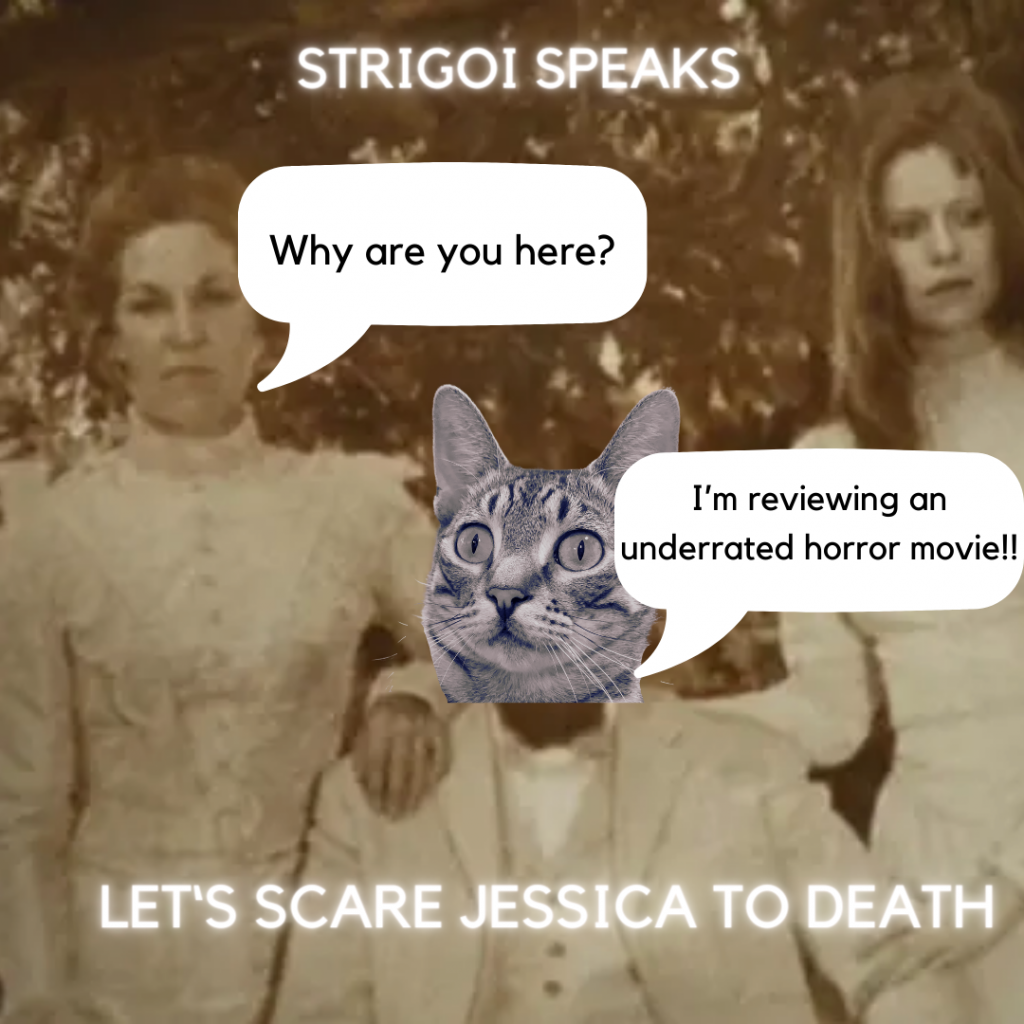

Let’s Scare Jessica to Death (1971) is the most underrated horror film of the 1970s. It elegantly integrates several genre subcategories, features an original monster, and introduces us to arguably the greatest horror heroine of all time. Artistically accomplished, it’s also a great popcorn movie with plenty of those quirky flourishes that give 70s horror that je ne sais quoi.
Recently released from a mental institution, Jessica, along with her husband, Duncan, and his friend, Woody, move from New York City to an old estate in the country. The point of the move is to provide Jessica with a bucolic setting where she can recover her health and the couple can get a fresh start. But their new beginning is threatened by Emily, a sexy squatter, who charms them into letting her stay. Soon, the mysterious stranger is seducing the men and communicating telepathically with Jessica, who notices her strong resemblance to the house’s previous occupant, the ill-fated Abigail Bishop. In the late nineteenth century, Bishop drowned on the eve of her wedding and is now reputed by superstitious locals to be a vampire. Is Emily a modern incarnation of a Victorian vamp or is Jessica losing her mind. Again.
Let’s Scare Jessica to Death seamlessly layers several horror themes and aesthetics, creating a unique fiend who exists in a liminal space between centuries. Here at Tracy’s Terrors, we toe a conservative party line on vampires, favoring creatures with extended canines who sleep in caskets, shun the daylight, fear garlic, and die by the stake. Measured against these standards, Emily is not a vampire, but a bloodsucking ghost with a physical body; a predator who attacks with a knife and turns her victims into hillbilly zombies. She defies traditional classifications and even collapses temporal contexts, exercising her power in the form of a counterculture drifter and then a Victorian maiden. Meanwhile, the town over which she presides seems to be stuck in the 1950s and is populated with crew-cut hicks who wouldn’t be uncomfortable in Deliverance (1972). Vampires, ghosts, zombies, and menacing rednecks? This might sound like spaghetti filmmaking–throw everything at the wall and see what sticks. But it’s actually elegant, understated, and creepy as hell.
Watching a lesser film, I might have spent my time marveling at the unusual mix of genre elements; but, here, I was fully engrossed in the ambiguous power dynamics between Jessica and Emily. This is an intense and sophisticated psychological drama. It’s strongly hinted that Abigail’s death was a suicide brought about by her imminent wedding. For that reason, I read her doppelganger, Emily, as a spirit of suppressed female rage and interpreted her communication with Jessica, a misunderstood woman surrounded by condescending men, as a sign of commiseration and friendship. But it’s much murkier than that: Is Emily trying to befriend her, seduce her, or drive her–in an echo of Abigail’s past–to suicide? The most frightening option is that her invasion of Jessica’s consciousness has nothing to do with camaraderie, a shared history of oppression, or sexual affinity. Maybe she doesn’t like Jessica; it’s simply that the beleaguered woman is the only one who can hear her. Jessica was institutionalized because she heard and saw her dead father. Now, her nascent psychic abilities are being exploited by a ghost who has no redeeming sense of empathy or justice.
When watching a horror movie, I typically root for the monsters and laugh as the main characters are picked off. In this case, however, I longed for Jessica to get the upper hand and crush her opponent. It’s rare that I become emotionally invested in a protagonist–years of genre films have compressed my heart into a tiny stone–but she’s unlike any scream queen I’ve ever encountered. While she has the standard badges of this sisterhood–psychologically fragile, an unreliable narrator–she also demonstrates a depth that most horror heroines lack. Jessica’s sensibility is at once morbid and cheerful. Evincing a childlike enthusiasm for the darkside, she joyfully preserves images of colonial tombstones, recites death poetry, and rides to the cemetery in the back of a hearse. You might be thinking this is all very Harold and Maude, another movie from 1971. But Jessica lacks the angst, rebellion, and pretentiousness of Harold. She isn’t driven by existential dread, nor is she attempting to shock others by disrupting cultural norms. Rather, her behavior is pure, unselfconscious expression. And this is surprising because, next to Emily, she looks like the embodiment of artifice and conservative values. With her short bob, A-line skirts, dense floral prints, and girlish sandals, she could be from a 50s clothing catalog; in contrast, Emily’s long hair, hip huggers and freelove attitude clearly align her with the counterculture. But looks are deceiving in this film and that’s why the female characters feel so complex and interesting.
Jessica’s dowdy appearance is belied by her fringe interests, and she demonstrates a worldliness that’s at odds with her generally innocent manner. Witnessing Duncan’s wandering eye, she seems indifferent to the possibility of marital infidelity and isn’t jealous of Emily’s youthful sex appeal. She’s also surprisingly steely when I expect her to be soft. Returning from the antiques dealer, she takes an imperious tone, telling her husband in no uncertain terms that his behavior was rude and will not be tolerated. And, later, when Duncan suggests that she return to New York, allowing him to use their primary asset (the country mansion) as a bachelor pad, she refuses, insisting that he leave her instead. Divorce attorneys everywhere applaud. An unusual mix of seemingly oppositional features, Jessica contains multitudes, and I am her biggest fan.
In this overwhelmingly positive review, I feel compelled to mention one flaw: The voiceover of Jessica’s internal dialogue is jarring and unnecessary. With an expressive face and posture, Zohra Lampert successfully conveys what the character is thinking, and we don’t need an audible rendering of her thoughts to spell it out. Such an intrusive tactic is an insult to the actor’s talent and the audience’s intelligence. That said, I forgive the director because of the hilarious (and also superfluous) DDT scenes. It takes real skill to make pesticide application gut-busting funny.